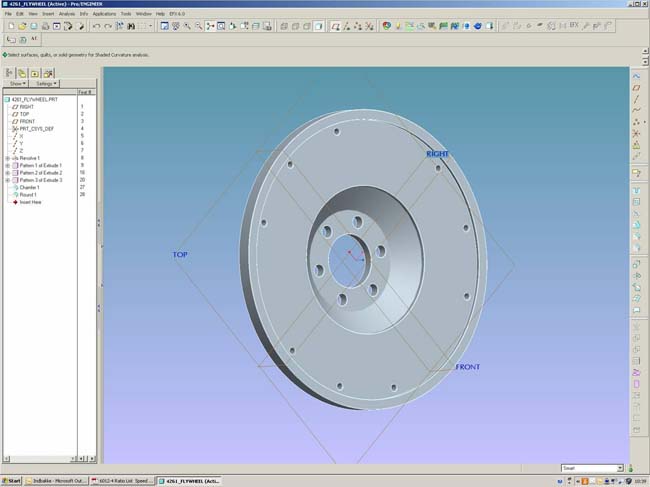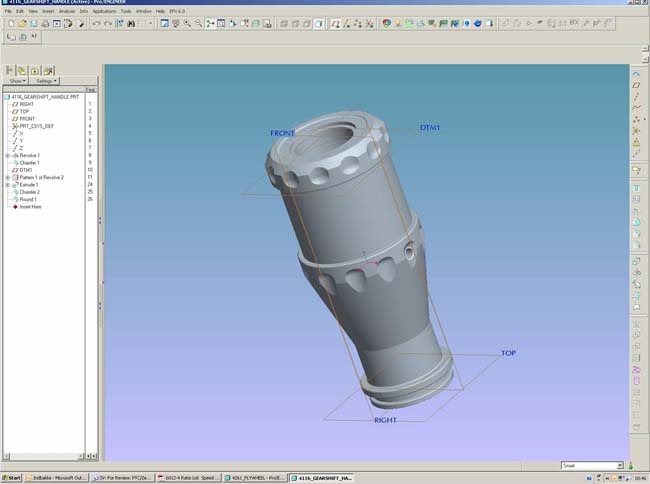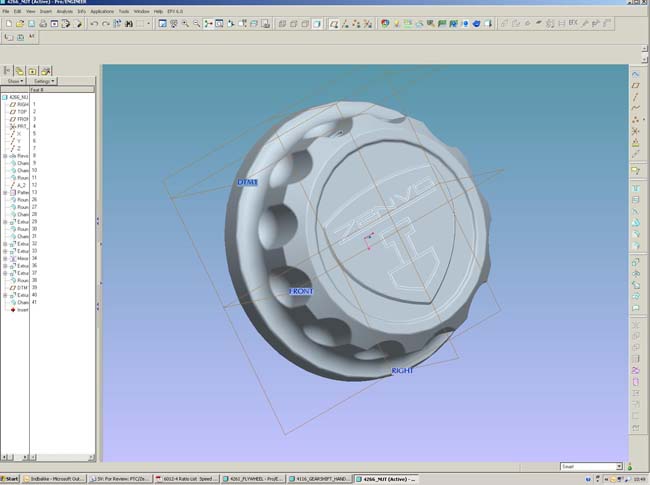Fast App: PTC’s Pro/Engineer Speeds Development of Denmark’s First Supercar
Zenvo Automotive leverages the design software's extensive functionality, user-friendly interface, ease of use, and extensive technical support to take its first first luxury supercar from concept into reality.
Latest News
April 26, 2010
By DE Editors
Those of us who drive regular “commute-to-work-and-back cars” or “shuttle-the-kids-to-soccer cars” may not know much about supercars. They are the fastest, most exotic, and most expensive cars in the world, with prices that can easily exceed 1 million euros. A cross between a sports car and a racecar, supercars exude status and exclusivity, which is often conferred on their owners.
 Figure 1. In 2009, Zenvo Automotive started production of a car named the Zenvo ST1. With its powerful turbo/supercharged V8 engine, rated at 823 kW, and 1,430 nm of torque, Denmark’s first supercar was designed with the ability to accelerate from 0 to 100 kph in 3 seconds and reach speeds of 375 kph. (Courtesy of Zenvo Automotive.) |
The First Danish Supercar
The brands that define luxury sports cars such as Lamborghini, Ferrari, Porsche, and Alpha Romeo also produce amped-up, ultra-high-end supercars. Now Zenvo Automotive joins their ranks.
When PTC spoke with Troels Vollertsen, CTO and co-founder of Zenvo Automotive, he had just put the Zenvo ST1 on a plane to Dubai for the Dubai International Motor Show. He sounded like a nervous parent, sending a child on a solo trip. But he would soon join his car in Dubai for an exclusive introduction to the wealthy Arab market.
“Our goal with the Zenvo ST1 was to make a comfortable supercar that my mother should be able to get in, and without any instruction, drive the car and totally succeed. Pro/ENGINEER from PTC allowed us to meet that goal. We have created the first luxury supercar.” Troels Vollertsen, CTO and co-founder, Zenvo Automotive |
Vollertsen explained that Zenvo Automotive is the first Danish manufacturer of supercars. The company wanted to design a luxury supercar that could be properly driven within city limits, as well as on a racing track. In 2009, Zenvo Automotive started production of a car named the Zenvo ST1 (Figure 1). It will be a limited edition, priced at 850,000 euros, with only 15 cars to be built and sold to specially approved customers.
Important Features
The company developed a clear list of criteria for its engineers and designers to ensure the car would not only be racetrack-worthy but also suitable for everyday use. After all, the affluent buyers of supercars not only want to drive fast but also want to be seen driving.
With its powerful turbo/supercharged V8 engine, rated at 823 kW, and 1,430 nm of torque, the Zenvo ST1 was designed with the ability to accelerate from 0 to 100 kph in 3 seconds and reach speeds of 375 kph. Yet, the design of car was paramount. The founders decided it wasn’t important that the Zenvo ST1 be the fastest car in the world, but they didn’t want their design to be compromised in the wind tunnel. They remained true to their goals and made sure the luxury supercar was both drivable and user friendly.
The Design Tool of Choice
Vollertsen has been designing fast cars for years. In 2004, he founded Zenvo, together with Jesper Jensen, financier and fast car expert, naming the company with a combination of their last names. They agreed on an idea and concept for the prototype, and Vollertsen started looking for design tools to create the supercar.
Although trained as an engineer, Vollertsen’s recent experience was on a managerial level, and he did not have much hands-on experience with 3D design tools. He spoke to friends and colleagues in the industry, and looked at tools from both PTC and SolidWorks. Ultimately, he selected PTC’s Pro/ENGINEER.
 Figure 2. Zenvo Automotive used PTC’s Pro/ENGINEER to develop the Zenvo ST1. Shown here is the supercar’s flywheel. (Courtesy of Zenvo Automotive.) |
“I was seeking advice from some CAD guys I know,” states Vollertsen. “Generally speaking, I was told to choose PTC because there is more of a future in this program. You can do more things with it, and there are more modules. I was also told that the support here in Denmark will be much better with PTC than with other companies.”
With a lean staff, Vollertsen couldn’t afford to take time away from the project for formal training, but he found that PTC’s Pro/ENGINEER was easy to learn. He explains, “It has been much easier than I was told. Everybody told me, ‘You need to work on this for serveral years to really learn it.’ But that was absolutely not true. There is a very good menu in Pro/ENGINEER, and it’s very easy to learn how to use it.” He was also impressed by the support team at PTC Denmark, who answered his calls promptly and were always helpful.
Prior to founding Zenvo, Vollertsen would have designed a new car by sitting with his CAD team and instructing them on how things should be done. But he realized that on this project he would need to roll up his sleeves and be much more involved. Vollertsen says, “I realized that I needed to get into it myself because otherwise this car wouldn’t have been possibly. I’ve spent more than a thousand hours on the computer for the Zenvo ST1 prototype. This project is precisely as I wanted it because I could just redo it and redo it until I was perfectly satisfied.”
From Concept to Show Floor
It took an average of four designers, four years to complete the Zenvo ST1 prototype. Unlike a major car manufacturer, such as Volkswagen, which starts out designing in 3D and has hundreds of engineers, Zenvo’s small team started by building the car’s frame by hand prototyping.
 Figure 3. Ease of use was a big factor in Zenvo’s decision to use Pro/ENGINEER. The software was used to ensure both form and function. (Courtesy of Zenvo Automotive.) |
Vollertsen elaborates, “When I was very confident with the system, we started working on the body. The first half of the mechanical engineering, which was underneath the body surface, was done by hand. I was actually drawing it. The second half of the engineering was done by computer with Pro/ENGINEER.”
Due to the surface modeling requirements of the body, Zenvo used a program called AF for surfacing. Afterwards they had to interface the body with the hand prototype. Vollertsen recalls, “I made all the interfaces for the body and the chassis with PTC in the computer.”
Small, independent car manufacturers often face challenges in terms of getting all the components to work together because this is hard to do from scratch. Vollertsen says he has worked with other companies, where he has seen wind or rain coming through the prototype’s windows or where the wipers or fans did not work properly. Yet, Pro/ENGINEER eliminated these issues for him. “Because of Pro/ENGINEER, we were able to take those concepts and hand-drawn ideas and fit them into a 3D CAD program that would tie everything together and make sure it all worked flawlessly.”
The Dubai Debut
The Zenvo ST1, a complete in-house development, from paper to production over the course of five years, certainly caused a stir when it was introduced. Its world premiere was at LeMans in June of 2009, where it was nominated “supercar of the year.” In December, it was on to Dubai, where the Zenvo ST1 was described in the automotive press as “stunning,” and the supercar garnered significant interest among prospective customers at the exhibition.
One of the big reasons that Zenvo is showing its cars at the Dubai International Motor Show is that wealthy individuals in the area want to own and show off a supercar. However, as Vollertsen explains, “Most supercars are difficult to drive. The clutch is very, very hard to push, and the steering wheel is hard to turn. And most of these cars are designed only to be driven on race tracks by professional drivers. The Zenvo ST1 is different—it can be driven on regular roads by regular people, and has the luxury interior features you would expect in a high end car.”
 Figure 4. The designers’ attention to detail can be seen even in the stylized wheelnut of the Zenvo ST1. (Courtesy of Zenvo Automotive.) |
In fact, Vollertsen and Jensen each had their wives test drive the car to get feedback from everyday drivers with no racing experience, and they both were able to drive it with no problems at all. “If you own a supercar and are driving along in Dubai or in Abu Dhabi and you hit traffic, you need to be able to drive quietly at 5 kph, too,” states Vollertsen. “And that fits with our goals—to have a useful supercar.”
Vollertsen concludes, “With Pro/ENGINEER, we were able to create the industry’s first luxury supercar. In the entire supercar class, the Zenvo ST1 has the lowest noise, is the most comfortable to drive, and is also the easiest to drive. You cannot do that in any other supercar, not even Ferrari.”
The team at Zenvo expects to build all 15 of the ST1 models by 2011, by which time two new models will be ready to go.
More Info
Parametric Technology Corp.
Subscribe to our FREE magazine, FREE email newsletters or both!
Latest News
About the Author
DE’s editors contribute news and new product announcements to Digital Engineering.
Press releases may be sent to them via [email protected].






